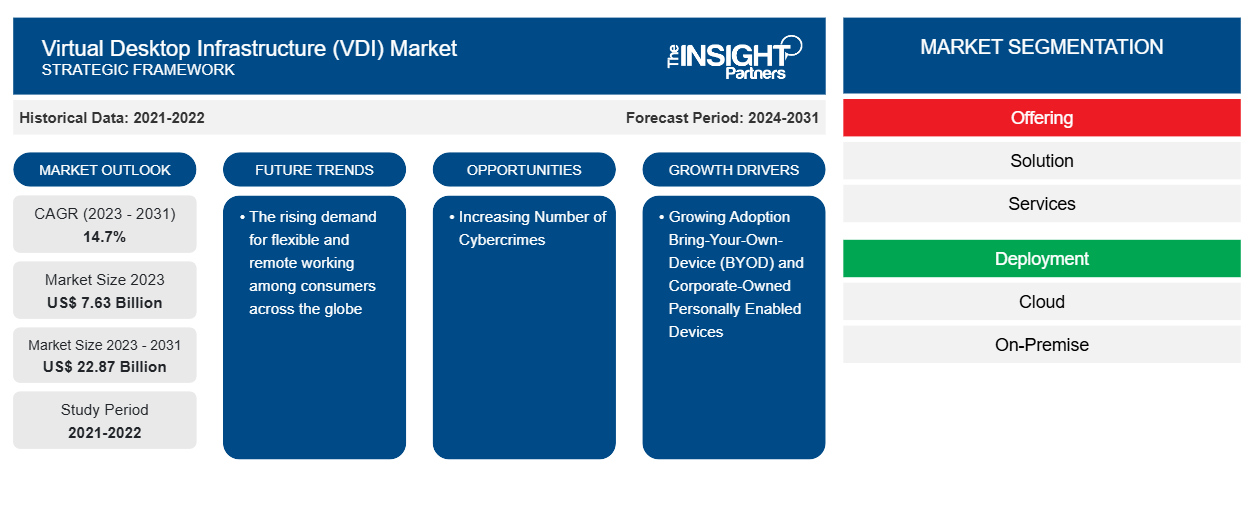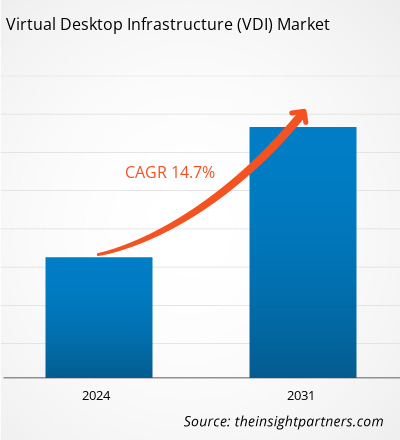The virtual desktop infrastructure (VDI) market size is projected to reach US$ 22.87 billion by 2031 from US$ 7.63 billion in 2023. The market is expected to register a CAGR of 14.7% in 2023–2031. The rising demand for flexible and remote working among consumers across the globe is likely to remain a key virtual desktop infrastructure (VDI) market trend.
Virtual Desktop Infrastructure (VDI) Market Analysis
The virtual desktop infrastructure (VDI) market is growing at a rapid pace due to the growing adoption of BYOD and corporate-owned personally enabled devices and growing security concerns among consumers. The market is expanding steadily, driven by expanding SMEs and stringent government regulations for security measures. Moreover, the increasing number of cybercrimes and integration of advanced technologies such as AI, cloud computing, and IoT in virtual desktop infrastructure are providing lucrative opportunities for market growth.
Virtual Desktop Infrastructure (VDI) Market Overview
Virtual desktop infrastructure (VDI) solutions are often built on a client/server architecture with the organization's operating system and applications. The VDI solutions are running on a server in the cloud or a data center. In this architecture, all interactions with users take place on a local device of the user's choice. VDI is also an important component of digital workplaces, due to the dependency of modern virtual desktop workloads rely on virtual desktop infrastructure technology, which runs on virtual machines either on-premises or public cloud data centers. This increases the use of virtual desktop infrastructure among businesses to streamline employees’ work is fueling the market.
Customize This Report To Suit Your Requirement
You will get customization on any report - free of charge - including parts of this report, or country-level analysis, Excel Data pack, as well as avail great offers and discounts for start-ups & universities
Virtual Desktop Infrastructure (VDI) Market: Strategic Insights

-
Get Top Key Market Trends of this report.This FREE sample will include data analysis, ranging from market trends to estimates and forecasts.
Virtual Desktop Infrastructure (VDI) Market Drivers and Opportunities
Growing Adoption Bring-Your-Own-Device (BYOD) and Corporate-Owned Personally Enabled Devices is Driving the Market
The expansion of the mobile workforce increases the demand for virtual desktop infrastructure for improving businesses’ productivity. The virtual desktop infrastructure benefits employees to access their virtual desktop images using their smartphones, laptops, and mobiles. The growing adoption of BYOD and corporate-owned individually enabled devices is propelling the demand for the virtual desktop infrastructure market in the IT and telecom industry. Businesses are working under pressure to adopt advanced virtual technologies attributed to the consumerization of IT, mobility, and BYOD. This increases their focus on developing advanced virtual desktop infrastructure to manage IT consumerization and costs. However, desktop virtualization is becoming increasingly popular due to enhanced security, compliance, and governance, which is expected to fuel the market during the forecast period.
Increasing Number of Cybercrimes – An Opportunity in the Virtual Desktop Infrastructure (VDI) Market
Advancements in virtualization technology surged the use of virtual desktop infrastructure among businesses for prioritizing security and compliance against data breaches and cyber-attacks. The increasing number of cybercrimes worldwide is creating opportunities in the market. For instance, According to BioCatch’s Digital Banking Fraud Trends in North America report of December 2023, mobile banking rates grew to 73% in 2023. This, in turn, caused a substantial rise in frauds executed via mobile devices, rising from 47% in 2022 to 61% in 2023. This increases the adoption of virtual desktop infrastructure among users to reduce risk and protect their data and information from cyberattacks.
Virtual Desktop Infrastructure (VDI) Market Report Segmentation Analysis
Key segments that contributed to the derivation of the virtual desktop infrastructure (VDI) market analysis are offering, deployment, enterprise size, and end user.
- Based on offering, the virtual desktop infrastructure (VDI) market is divided into solution and services. The solution segment held a larger market share in 2023.
- In terms of deployment, the market is categorized as cloud and on-premise. The cloud segment held a larger market share in 2023.
- On the basis of enterprise size, the virtual desktop infrastructure (VDI) market is divided into SMEs and large enterprises. The SMEs segment held a larger market share in 2023.
- In terms of end user, the virtual desktop infrastructure (VDI) market is segmented into IT & telecom, government, healthcare, BFSI, education, retail, manufacturing, and other end users. The IT & telecom segment held a larger market share in 2023.
Virtual Desktop Infrastructure (VDI) Market Share Analysis by Geography
The geographic scope of the virtual desktop infrastructure (VDI) market report is mainly divided into five regions: North America, Asia Pacific, Europe, Middle East & Africa, and South America/South & Central America.
In terms of revenue, North America accounted for the largest virtual desktop infrastructure (VDI) market share, due to the growing adoption of cloud technology among enterprises. Growing demand for virtual desktop infrastructure from IT & telecom, gaming, consumer electronics, and entertainment industries to improve collaborative working by enhancing operational efficiency is driving the market. Moreover, employees' preference for flexible and remote working is boosting the virtual desktop infrastructure (VDI) market in the near future.
Virtual Desktop Infrastructure (VDI) Market Regional InsightsThe regional trends and factors influencing the Virtual Desktop Infrastructure (VDI) Market throughout the forecast period have been thoroughly explained by the analysts at The Insight Partners. This section also discusses Virtual Desktop Infrastructure (VDI) Market segments and geography across North America, Europe, Asia Pacific, Middle East and Africa, and South and Central America.
Virtual Desktop Infrastructure (VDI) Market Report Scope
| Report Attribute | Details |
|---|---|
| Market size in 2023 | US$ 7.63 Billion |
| Market Size by 2031 | US$ 22.87 Billion |
| Global CAGR (2023 - 2031) | 14.7% |
| Historical Data | 2021-2022 |
| Forecast period | 2024-2031 |
| Segments Covered |
By Offering
|
| Regions and Countries Covered |
North America
|
| Market leaders and key company profiles |
|
Virtual Desktop Infrastructure (VDI) Market Players Density: Understanding Its Impact on Business Dynamics
The Virtual Desktop Infrastructure (VDI) Market is growing rapidly, driven by increasing end-user demand due to factors such as evolving consumer preferences, technological advancements, and greater awareness of the product's benefits. As demand rises, businesses are expanding their offerings, innovating to meet consumer needs, and capitalizing on emerging trends, which further fuels market growth.

- Get the Virtual Desktop Infrastructure (VDI) Market top key players overview
Virtual Desktop Infrastructure (VDI) Market News and Recent Developments
The virtual desktop infrastructure (VDI) market is evaluated by gathering qualitative and quantitative data post primary and secondary research, which includes important corporate publications, association data, and databases. The following is a list of developments in the market for virtual desktop infrastructure (VDI) and strategies:
- In August 2023, VMware, Inc. VMware announced modern AI integrations to the Anywhere Workspace platform that automatically optimize employee experience, drive new vulnerability management use cases, and simplify application lifecycle management. VMware Anywhere Workspace is the only hybrid work platform that integrates digital employee experience (DEX), virtual desktop infrastructure and apps (VDI and DaaS), unified endpoint management (UEM), and security to enable a seamless and secure workspace on any device or location. (Source: VMware, Inc., Press Release, 2023)
- In September 2022, Amazon.com, Inc announced Amazon WorkSpaces Core, a new, fully managed virtual desktop infrastructure (VDI) service that combines the security, global reliability, and cost efficiency of AWS with existing VDI management solutions. (Source: Amazon.com, Inc, Press Release, 2023)
Virtual Desktop Infrastructure (VDI) Market Report Coverage and Deliverables
The “Virtual Desktop Infrastructure (VDI) Market Size and Forecast (2021–2031)” report provides a detailed analysis of the market covering below areas:
- Market size and forecast at global, regional, and country levels for all the key market segments covered under the scope
- Market dynamics such as drivers, restraints, and key opportunities
- Key future trends
- Detailed PEST/Porter’s Five Forces and SWOT analysis
- Global and regional market analysis covering key market trends, major players, regulations, and recent market developments
- Industry landscape and competition analysis covering market concentration, heat map analysis, prominent players, and recent developments
- Detailed company profiles
Frequently Asked Questions
What is the incremental growth of the global virtual desktop infrastructure (VDI) market during the forecast period?
What will be the market size of the global virtual desktop infrastructure (VDI) market by 2031?
Which are the key players holding the major market share of the global virtual desktop infrastructure (VDI) market?
What are the future trends of the global virtual desktop infrastructure (VDI) market?
What are the driving factors impacting the global virtual desktop infrastructure (VDI) market?
What is the estimated market size for the global virtual desktop infrastructure (VDI) market in 2023?
- Historical Analysis (2 Years), Base Year, Forecast (7 Years) with CAGR
- PEST and SWOT Analysis
- Market Size Value / Volume - Global, Regional, Country
- Industry and Competitive Landscape
- Excel Dataset
Recent Reports
Testimonials
Reason to Buy
- Informed Decision-Making
- Understanding Market Dynamics
- Competitive Analysis
- Identifying Emerging Markets
- Customer Insights
- Market Forecasts
- Risk Mitigation
- Boosting Operational Efficiency
- Strategic Planning
- Investment Justification
- Tracking Industry Innovations
- Aligning with Regulatory Trends





















 Get Free Sample For
Get Free Sample For